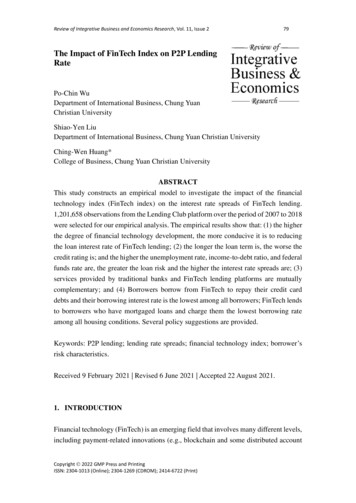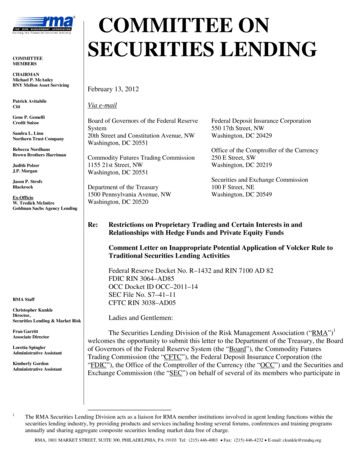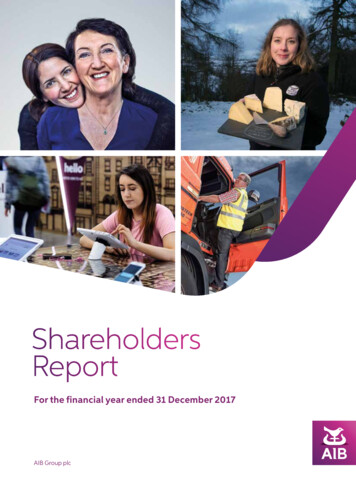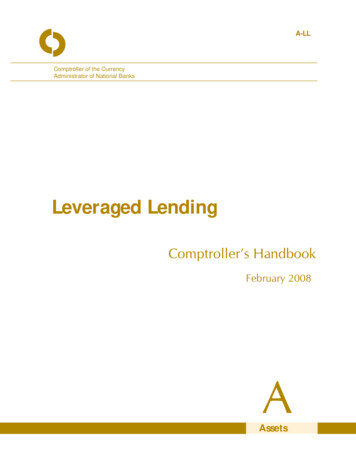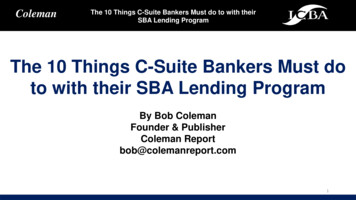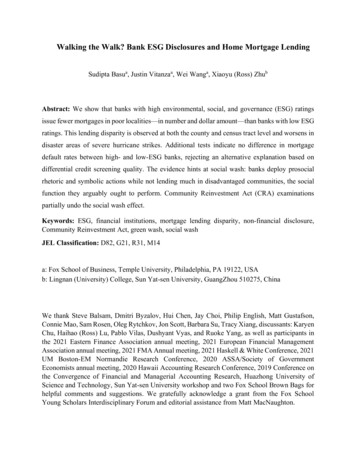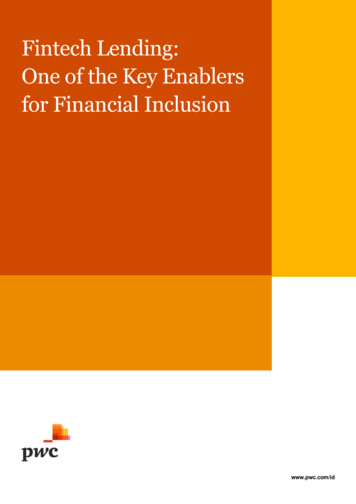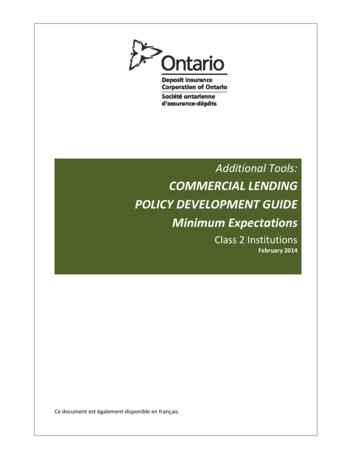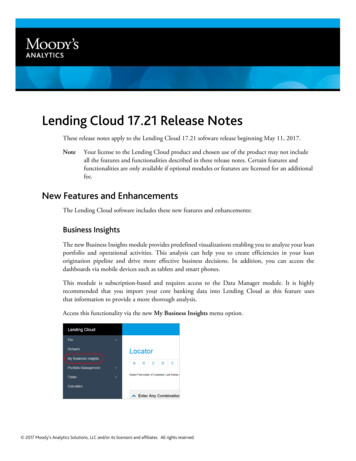
Transcription
4 May 2017Lending Cloud 17.21 Release NotesThese release notes apply to the Lending Cloud 17.21 software release beginning May 11, 2017.NoteYour license to the Lending Cloud product and chosen use of the product may not includeall the features and functionalities described in these release notes. Certain features andfunctionalities are only available if optional modules or features are licensed for an additionalfee.New Features and EnhancementsThe Lending Cloud software includes these new features and enhancements:Business InsightsThe new Business Insights module provides predefined visualizations enabling you to analyze your loanportfolio and operational activities. This analysis can help you to create efficiencies in your loanorigination pipeline and drive more effective business decisions. In addition, you can access thedashboards via mobile devices such as tablets and smart phones.This module is subscription-based and requires access to the Data Manager module. It is highlyrecommended that you import your core banking data into Lending Cloud as this feature usesthat information to provide a more thorough analysis.Access this functionality via the new My Business Insights menu option. 2017 Moody’s Analytics Solutions, LLC and/or its licensors and affiliates. All rights reserved.
Business Insights VisualizationsThe following seven dashboards are available:Note User access to the dashboards can be managed by system administrators.Portfolio Overview I—Provides a complete view of an institution’s loan portfolio based on a seriesof categorizations. Examples include concentrations by NAICS industry codes, risk rating scale,and probability of default.The following is an example of the Portfolio Overview I dashboard.Each dashboard will display multiple visualizations, such as graphs, charts, and tables. In addition,the content in these visualizations can be filtered to narrow the display of information.2 Portfolio Overview II—Provides a view of an institution’s loan portfolio based on concentrationsby past due amounts and account type. Portfolio Risk—Provides insights into an institution’s risk portfolio, based on the branch wherethe loan was created. Geographic—Provides a view into the location based loan information by geographic region,lender, and business entity. Operational Workflow I—Displays the duration of the institution’s loan process. The visualsprovide insight into the number of workflows in various past due categories by account managerand assignee. You can drill down from the workflow template to individual workflows and also totasks specific to the workflow. Operational Workflow II—Displays the time/duration based information by individual task andassignee within a workflow. It provides you with an ability to drill down from the workflowtemplate to individual task level information to calculate the total effort on a type of workflow.Moody’s Analytics, Moody’s, and all other names, logos, and icons identifying Moody’s Analytics and/or its products and services are trademarks of Moody’sAnalytics or its licensors. Third-party trademarks referenced herein are the property of their respective owners.
Operational Performance Monitor—Enables you to monitor how the workflows, or the loanorigination system, is performing. You can identify the actions taking the longest time, therebyproviding the information necessary to improve the process.The following filters on this dashboard allow you to analyze the data based on different dimensions: Workflow Status—This is client-defined. For example, Closed, In Progress, Declined,Withdrawn). Workflow Template—This is client-defined. For example, Express, Capital Markets. Workflow Duration Group—This is pre-defined in the dashboard ( 30 Days, 30-59 Days,60-89 Days, 90Days ). Account manager—This is client-defined. Task Title—This is client-defined. Task Assignee—This is client-defined.Ticklers EnhancementsYou can easily establish recurring quarterly, semi-annual, and yearly ticklers to facilitate the collectionof financial reports and tax returns.Setting up Tickler Templates for Quarterly and Semi-Annual TicklersOn the Edit Template Data screen, in the Schedule Rule drop-down list, the new Quarterly and SemiAnnual frequency options are available when you select Recurring Due Date. If you select one of thesenew options, the following fields are required: Prompt For First Day of Reporting Cycle—This check box in the Schedule Rule field prompts auser to enter the start date of the reporting cycle being collected when the tickler is added to acustomer. This field is automatically selected and cannot be cleared when the new frequencyoptions are selected. Due Date (Days after End of Reporting Cycle)—This field establishes the due date based on theend of the reporting cycle for the collected report(s).NoteWhen selecting a yearly schedule rule, the Prompt For First Day of Reporting Cycle checkbox in the Schedule Rule field is now available and activates the Due Date (Days after End ofReporting Cycle) field. In addition, the Start field name has changed to Activation.Using Templates for Quarterly, Semi-Annual, and Yearly TicklersOn the Add Ticklers tab, when you use templates or packages with the new frequency options to addticklers to a customer, a table appears below the Selected Ticklers section that contains the followingfields: Enter First Day of Reporting Cycle—When you enter this date, the system automaticallycalculates the Activation Date and the Due Date based on the rules in the template.Lending Cloud 17.21 Release Notes3
Reporting Schedule Rule—Displays Quarterly, Semi-Annual, Yearly. Activation Date—You can edit this automatically calculated date; however, it only affects the firsttickler in the series. Remaining ticklers in the series will then return to the rules as established onthe template. Due Date—You can edit this automatically calculated date; however, it only affects the first ticklerin the series. Remaining ticklers in the series return to the rules as established on the template.In the following example, a user has specified that the quarterly tickler will begin with the thirdcalendar quarter of 2017 and the semi-annual tickler will not begin until the first half of 2018. View Series—This link displays the Tickler Series Preview table containing the earliest ticklers inthe series. Up to eight ticklers can appear. This enables you to check the accuracy of your ticklersetup before you save and establish the series.Ad Hoc Ticklers for Quarterly, Semi-Annual, and Yearly TicklersThe new frequency options are available if you add an ad hoc tickler to the customer instead of usinga template. The setup options on the Create Tickler screen are the same as those provided whenestablishing a template except that you specify the first day the of reporting cycle. The new PreviewSeries button enables you to preview the earliest ticklers in the series.Debt Schedule Loan OrderYou can display loans on the Debt Schedule screen in loan type order, with current loans appearingfirst, followed by non-current loans. When sorted by loan type, the principal balance is the secondarysorting order. This functionality affects loans appearing on the Our Debt and Other Debt tabs.4Moody’s Analytics, Moody’s, and all other names, logos, and icons identifying Moody’s Analytics and/or its products and services are trademarks of Moody’sAnalytics or its licensors. Third-party trademarks referenced herein are the property of their respective owners.
System administrators use the new Debt Schedule Loan Order drop-down list on the Debt ScheduleSetup screen to set the loan order. This field is initially set to Principal Balance which maintains thecurrent loan order.New Coverage Ratios Added to the Ratios & Indicators ReportThe following ratios are available to add to the Financial Leverage / Coverage Ratios section of theRatios & Indicators report: EBITDA / Interest Exp CPLTD UCA Cash Flow Coverage / CPLTDNew and Updated Farm Service Agency (FSA) FormsThe FSA-2210, Application for EZ Guarantee form, is available to add to credit actions. The new2210 EZ form is added in the same manner as the existing 2211 and 2212 (PLP ONLY) forms. Inaddition, the 2211and 2212 (PLP ONLY) forms have been updated to reflect the FSA’s currentversions of these forms.New Reports Available for Report PackagesThe following reports are available to add to report packages on the Print Manager screen: Industry Comparison reports Industry Comparison Trends report Statement of Owner Equity - Details reportNew Security FeatureAs part of this release, only Lending Cloud users who are logged into the application can complete aneSignature.Release ResourcesDocumentation for This ReleaseYou can access the product documentation for this release on Lending Cloud’s eHelp.Product TrainingTo find training materials or learn more about training opportunities send an email or visit one of thefollowing: Lending Cloud product information page:Lending Cloud 17.21 Release Notes5
-Origination/Lending-Cloud OnPoint LMS page: https://gm1.geolearning.com/geonext/webequity/Send an email to trainingwes@moodys.com to request an OnPoint login ID and password.Lending Cloud SupportYou can reach Lending Cloud Support at:Phone: 1-800-264-0787Email: supportwes@moodys.com6Moody’s Analytics, Moody’s, and all other names, logos, and icons identifying Moody’s Analytics and/or its products and services are trademarks of Moody’sAnalytics or its licensors. Third-party trademarks referenced herein are the property of their respective owners.
UCA Cash Flow Coverage / CPLTD New and Updated Farm Service Agency (FSA) Forms The FSA-2210, Application for EZ Guarantee form, is available to add to credit actions. The new 2210 EZ form is added in the same manner as the existing 2211 and 2212 (PLP ONLY) forms. In
